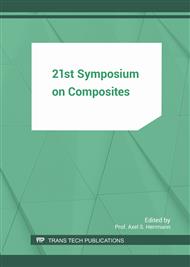[1]
T. Kraus (CCeV), M. Kühnel (CCeV), E. Witten (AVK), Composites-Marktbericht 2015, Marktentwicklungen, Trends, Ausblicke und Herausforderungen.
Google Scholar
[2]
T. Roberts, The Carbon Fibre Industry Worldwide 2008-2014, An Evaluation of Current Markets and Future Supply and Demand, Materials Technology Publications (2008).
Google Scholar
[3]
M. Gehr, Recycled Carbon Fibre: A New Approach to Cost Effective Lightweighting, ReThink - Travelling Conference 16. 11. (2016).
Google Scholar
[4]
F. Manis et al., Bewertung der mechanischen und ökologischen Aspekte des thermischen Recyclings, 4. Symposium Rohstoffeffizienz und Rohstoffinnovationen (2016).
Google Scholar
[5]
A. Schneller, et al., Recycling of woven carbon fiber patches from laminated CFRP by means of induction heating 20. ICCM (2015).
Google Scholar
[6]
D. Achilias et al., Recent Advances in the Chemical Recycling of Polymers (PP, PS, LDPE, HDPE, PVC, PC, Nylon, PMMA), Material Recycling - Trends and Perspectives (2012).
DOI: 10.5772/33457
Google Scholar
[7]
A. Greco, et al, (2013): Thermal and chemical treatments of recycled carbon fibres for improved adhesion to polymeric matrix. In: Journal of Composite Materials 47 (3), (2013) 369–377.
DOI: 10.1177/0021998312440133
Google Scholar
[8]
G. Oliveux, B. Jean-Luc, E. Salle, Chemical recycling of glass fibre reinforced composites using subcritical water. Composites Part A: Applied Science and Manufacturing 43 (11), (2012) 1809–1818.
DOI: 10.1016/j.compositesa.2012.06.008
Google Scholar
[9]
F. Manis, A. Schneller, J. Wölling, Ganzheitliche Recycling-Prozesskette für Carbonfasergewebe und Gelege, Lightweight Design (5), S. 14–19, (2016).
DOI: 10.1007/s35725-016-0048-2
Google Scholar
[10]
A. Stevenson, Recycling carbon fibre: State of the art and future developments, International Textile Conference (2016).
Google Scholar
[11]
S. Pickering, Processing recovered carbon fibre into nonwovens for polymer composite application, Nonwoven Innovation Academy, Leeds, (2015) 234–249.
Google Scholar
[12]
T. Habers, C. Ebel, K. Drechsler, Highly Efficient Production and Characterizsation of CFRP Made from Recycled Carbon Fibres, Sampe Journal 50 (3) (2014) 7-13.
Google Scholar
[13]
A. Hohmann et al., MAI Enviro. Vorstudie zur Lebenszyklusanalyse mit ökobilanzieller Bewertung relevanter Fertigungsprozessketten, Fraunhofer Verlag (2015).
Google Scholar
[14]
M. Sharma et al., Carbon fiber surfaces and composite interphases, Composites Science and Technology 102, S. 35–50 (2014).
Google Scholar
[15]
J. M. Park et al., Effect of thermal treatment temperatures on the reinforcing and interfacial properties of recycled carbon fiber–phenolic composites, Composites Part A: Applied Science and Manufacturing 47, (2012) 156–164.
DOI: 10.1016/j.compositesa.2012.12.002
Google Scholar
[16]
MAI Recycling – Entwicklung ressourceneffizienter CFK-Recyclingverfahren und Prozessketten für die künftige Bereitstellung qualitativ hochwertiger rC-Halbzeuge, Förderkennzeichen: 03MAI03A, Abschlussbericht (2015).
Google Scholar
[17]
ForCycle - Ressourceneffiziente Faser-Matrix-Separation für das Recycling von Carbonfaserstrukturen, Förderkennzeichen: BAF01SoFo-65339, Abschlussbericht (2017).
Google Scholar
[18]
Werkstoff- und Prozessentwicklung für thermoformbare hochleistungsfaserverstärkte Halbzeuge in Serienprozessen, Förderkennzeichen: MF110118, Abschlussbericht (2014).
Google Scholar
[19]
P. Wiedemann, CF/TP Recycling –Einblicke aus der Recyclingindustrie, CCeV. AG Thermoplaste 16. 11. (2016).
Google Scholar
[20]
C. Georgen, S. Baz, P. Mitschang, InTeKS - Neuartige Organobleche aus recycleten Kohlenstofffasern, Symposium Experience Composites 22. 09. (2016).
Google Scholar
[21]
M. L. Longana, Multiple closed loop recycling of carbon fibre composites with the HiPerDiF (High Performance Discontinuous Fibre) method, Composite Structures 153 (2016) 217-277.
DOI: 10.1016/j.compstruct.2016.06.018
Google Scholar
[22]
T. A. Turner, N.A. Warrior, S.J. Pickering, Re-Use of carbon fibres in high value moulding compounds & pre-pregs, 17. ICCM (2009).
Google Scholar


